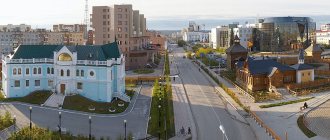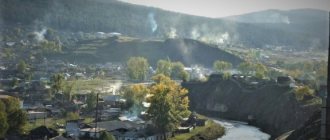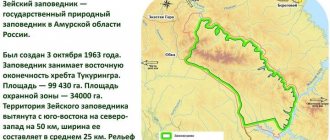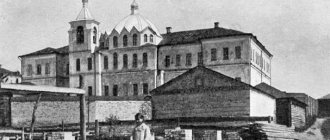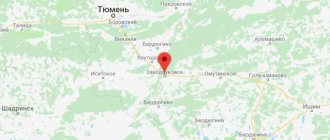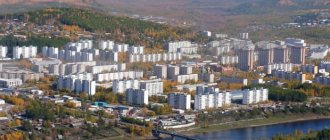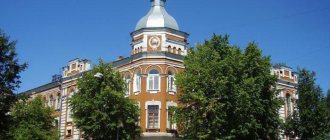This term has other meanings, see Spirituality (meanings).
| City Spirituality Coat of arms |
| A country | Russia, Russia |
| Subject of the federation | Smolensk regionSmolensk region |
| Municipal district | Dukhovshchinsky |
| Coordinates | 55°12′00″ n. w. 32°25′00″ E. d. / 55.20000° n. w. 32.41667° east d. / 55.20000; 32.41667 (G) [www.openstreetmap.org/?mlat=55.20000&mlon=32.41667&zoom=12 (O)] (Z)Coordinates: 55°12′00″ N. w. 32°25′00″ E. d. / 55.20000° n. w. 32.41667° east d. / 55.20000; 32.41667 (G) [www.openstreetmap.org/?mlat=55.20000&mlon=32.41667&zoom=12 (O)] (I) |
| First mention | 1675 |
| City with | 1777 |
| Square | 11 km² |
| Center height | 220 |
| Population | ↗4171[1] people (2016) |
| Names of residents | clergymen, clergyman |
| Timezone | UTC+3 |
| Telephone code | +7 48166 |
| Postal codes | 216200 |
| Vehicle code | 67 |
| OKATO code | [classif.spb.ru/classificators/view/okt.php?st=A&kr=1&kod=66216501 66 216 501] |
| country map |
Audio, photo and video
on Wikimedia Commons
Spirituality
- a city in Russia, the administrative center of the Dukhovshchinsky district of the Smolensk region. The city is located on the Vostitsa River (Dnieper basin), 57 km from Smolensk. Population - 4.1 thousand people. (2009; 4.6 thousand according to the 2002 census).
Story
On the site of modern Dukhovshchina in the XIII-XIV centuries. there was a women's Spiritual Monastery (its church was consecrated in the name of the Holy Spirit). In the 15th or 16th centuries, the Dukhovskaya Sloboda arose around the monastery. From the second half of the 17th century, Dukhovshchina was the center of the camp, then the volost.
By decree of February 18, 1777, it was ordered to move the district center from the city of Kaspli to the village of Dukhovshchina, calling it the city of Dukhovshchina. The new district received the name Dukhovskoy. In 1796, the Dukhovskoy district was liquidated, and the newly formed city was removed from the state, but on April 24, 1802 it was restored as a district town, and the district began to be called Dukhovshchinsky.
The coat of arms of the city of Dukhovshchina was approved on October 10, 1780: “In a white field there is a rose bush producing a pleasant perfume”
.[2]
During the Patriotic War of 1812, Dukhovshchina suffered significantly.
In 1925, the center of the district from Dukhovshchina was transferred to the village of Yartsevo[3].
On October 1, 1929, the Western Region was formed, within which the Dukhovshchinsky district was formed, with its center in the city of Dukhovshchina.
On July 15, 1941, the city was occupied by Nazi troops. On September 19, 1943, the city was liberated by the troops of the Kalinin Front during the Dukhovshchinsko-Demidov operation - by the forces of the 39th Army and Long-Range Aviation. In honor of the liberation of the city, a salute was given in Moscow with 12 artillery salvoes from 124 guns[4].
Spirituality
(Smolensk region)
OKATO code:
66216501
Founded:
16th century.
City since:
1777 City of district subordination (Dukhovshchinsky district, Smolensk region)
Center:
Dukhovshchinsky district
Telephone code (reference phone)
| 48166***** | — |
Deviation from Moscow time, hours:
0
Geographic latitude:
55°12′
Geographic longitude:
32°25′
Altitude above sea level, meters:
220 Sunrise and sunset times in the city of Dukhovshchina
Population
| Population | ||||||
| 1856[5] | 1897[5] | 1913[5] | 1926[5] | 1931[5] | 1959[6] | 1970[7] |
| 2700 | ↗3100 | ↗6600 | ↘2900 | ↘2700 | ↗3293 | ↗4420 |
| 1979[8] | 1989[9] | 1992[5] | 1996[5] | 1998[5] | 2000[5] | 2001[5] |
| ↗5114 | ↗5747 | ↗5800 | →5800 | ↘5600 | ↘5400 | →5400 |
| 2002[10] | 2003[5] | 2005[5] | 2006[5] | 2007[5] | 2008[11] | 2009[12] |
| ↘4683 | ↗4700 | ↘4500 | ↘4400 | ↘4300 | ↘4200 | ↘4137 |
| 2010[5] | 2011[5] | 2012[13] | 2013[14] | 2014[15] | 2015[16] | 2016[1] |
| ↘4100 | ↗4400 | ↘4225 | ↘4100 | ↗4117 | ↗4125 | ↗4171 |
Notable natives and residents
18 km from Dukhovshchina, in the village of Chizhevo, G. A. Potemkin was born. Also not far from Dukhovshchina, in the village of Sutoki, the poet and writer Fyodor Nikolaevich Glinka was born[17].
The following people lived and studied in Dukhovshchina:
- Kozlov, Pyotr Kuzmich (1863-1935) - explorer of Central Asia.
- Zhukov, Grigory Nikitich (1902-1975) - Soviet military leader, Major General. Hero of the Soviet Union.
- Ardamatsky, Vasily Ivanovich (1911-1989) - Soviet writer, film screenwriter.
- Egorov, Sergei Mikhailovich (1913-1969) - Hero of Socialist Labor.
- B. N. Petrov - Academician of the USSR Academy of Sciences), first president of the Council for International Cooperation in the Field of Research and Use of Outer Space at the USSR Academy of Sciences - Intercosmos;
- E. P. Emelchenkov - Head of the Department of Informatics, Smolensk State University, Candidate of Physical and Mathematical Sciences;
- S. P. Emelchenkov - Deputy General Director of the Federal State Unitary Enterprise "Russian Post" for information technology, development of new products.
Notes
- ↑ 12
www.gks.ru/free_doc/doc_2016/bul_dr/mun_obr2016.rar Population of the Russian Federation by municipalities as of January 1, 2016 - "Urban settlements in the Russian Empire", 1864, volume 4.
- THE USSR. Administrative-territorial division of the union republics on January 1, 1980 / Compiled by V. A. Dudarev, N. A. Evseeva. - M.: Publishing house "Izvestia of the Soviets of People's Deputies of the USSR", 1980. - 702 p. — P. 224.
- militera.
[militera.lib.ru/h/liberation/01.html Liberation of cities: A guide to the liberation of cities during the Great Patriotic War 1941–1945]. M.: Military Publishing House. [www.webcitation.org/619JbHkl0 Archived from the original on August 23, 2011]. - ↑ 12345678910111213141516
[www.MojGorod.ru/smolensk_obl/duhovschina/index.html People's encyclopedia “My City”. Spiritualism]. Retrieved June 23, 2014. [www.webcitation.org/6QY2JEPMl Archived from the original on June 23, 2014]. - [demoscope.ru/weekly/ssp/rus59_reg2.php All-Union Population Census of 1959. The size of the urban population of the RSFSR, its territorial units, urban settlements and urban areas by gender] (Russian). Demoscope Weekly. Retrieved September 25, 2013. [www.webcitation.org/6GDOghWC9 Archived from the original on April 28, 2013].
- [demoscope.ru/weekly/ssp/rus70_reg2.php All-Union Population Census of 1970 The size of the urban population of the RSFSR, its territorial units, urban settlements and urban areas by gender.] (Russian). Demoscope Weekly. Retrieved September 25, 2013. [www.webcitation.org/6GDOiMstp Archived from the original on April 28, 2013].
- [demoscope.ru/weekly/ssp/rus79_reg2.php All-Union Population Census of 1979 The size of the urban population of the RSFSR, its territorial units, urban settlements and urban areas by gender.] (Russian). Demoscope Weekly. Retrieved September 25, 2013. [www.webcitation.org/6GDOjhZ5L Archived from the original on April 28, 2013].
- [demoscope.ru/weekly/ssp/rus89_reg2.php All-Union Population Census of 1989. Urban population]. [www.webcitation.org/617x0o0Pa Archived from the original on August 22, 2011].
- [www.perepis2002.ru/ct/doc/1_TOM_01_04.xls All-Russian Population Census 2002. Volume. 1, table 4. Population of Russia, federal districts, constituent entities of the Russian Federation, districts, urban settlements, rural settlements - regional centers and rural settlements with a population of 3 thousand or more]. [www.webcitation.org/65AdCU0q3 Archived from the original on February 3, 2012].
- [www.gks.ru/bgd/regl/b08_14t/IssWWW.exe/Stg/z/13.htm Cities of the Smolensk region (number of inhabitants - estimate as of January 1, 2008, thousand people)]. Retrieved May 28, 2016. [www.webcitation.org/6hqLx9liu Archived from the original on May 28, 2016].
- [www.gks.ru/bgd/regl/B09_109/IssWWW.exe/Stg/d01/tabl-21-09.xls Number of permanent population of the Russian Federation by cities, urban-type settlements and districts as of January 1, 2009]. Retrieved January 2, 2014. [www.webcitation.org/6MJmu0z1u Archived from the original on January 2, 2014].
- [www.gks.ru/free_doc/doc_2012/bul_dr/mun_obr2012.rar Population of the Russian Federation by municipalities. Table 35. Estimated resident population as of January 1, 2012]. Retrieved May 31, 2014. [www.webcitation.org/6PyOWbdMc Archived from the original on May 31, 2014].
- [www.gks.ru/free_doc/doc_2013/bul_dr/mun_obr2013.rar Population of the Russian Federation by municipalities as of January 1, 2013. - M.: Federal State Statistics Service Rosstat, 2013. - 528 p. (Table 33. Population of urban districts, municipal districts, urban and rural settlements, urban settlements, rural settlements)]. Retrieved November 16, 2013. [www.webcitation.org/6LAdCWSxH Archived from the original on November 16, 2013].
- [www.gks.ru/free_doc/doc_2014/bul_dr/mun_obr2014.rar Table 33. Population of the Russian Federation by municipalities as of January 1, 2014]. Retrieved August 2, 2014. [www.webcitation.org/6RWqP50QK Archived from the original on August 2, 2014].
- [www.gks.ru/free_doc/doc_2015/bul_dr/mun_obr2015.rar Population of the Russian Federation by municipalities as of January 1, 2015]. Retrieved August 6, 2015. [www.webcitation.org/6aaNzOlFO Archived from the original on August 6, 2015].
- Page [www.admin.smolensk.ru/~duhov/Istoriya.html Historical information] on the website of the municipal formation "Dukhovshchinsky district"
- Shestakov P. D.
[www.memoirs.ru/rarhtml/Shestakov_IV91_3.htm Memories of V. I. Nazimov] //
Historical Bulletin
, 1891. - T. 43. - No. 3. - P. 707.
Map
| Spirituality: cards |
Dukhovshchina: photo from space (Google Maps) Dukhovshchina: photo from space (Microsoft Virtual Earth)
| Spirituality. Nearest cities. Distances in km. on the map (in brackets along roads) + direction. Using the hyperlink in the distance , you can get the route (information courtesy of the AutoTransInfo website) | |||
| 1 | Yartsevo | 22 (23) | SE |
| 2 | Kardymovo | 34 (41) | YU |
| 3 | Ozerny | 42 (46) | WITH |
| 4 | Smolensk | 51 (55) | SW |
| 5 | Safonovo | 54 (64) | IN |
| 6 | Demidov | 57 (70) | Z |
| 7 | Verkhnedneprovsky | 64 (84) | SE |
| 8 | Dorogobuzh | 64 (91) | SE |
| 9 | Glinka | 68 (149) | SE |
| 10 | Zharkovsky (Tver region) | 72 (273) | WITH |
| 11 | Kholm-Zhirkovsky | 76 (106) | NE |
| 12 | White | 77 (95) | NE |
| 13 | Yelnya | 85 (131) | SE |
| 14 | Pochinok | 88 (107) | YU |
| 15 | Velizh | 88 (116) | NW |
| 16 | Rudnya | 90 (115) | Z |
| 17 | Red | 94 (110) | SW |
| 18 | Monasticism | 101 (111) | YU |
| 19 | Khislavichi | 114 (137) | YU |
| 20 | Nelidovo | 115 (143) | WITH |
| 21 | Vyazma | 119 (140) | Z |
| 22 | Western Dvina | 120 (194) | WITH |
a brief description of
The city is located in the west of the Smolensk-Moscow Upland, on the river. Vostitsa (Dnieper basin), 12 km from the railway. Eryshi station, 57 km northeast of Smolensk.
Territory (sq. km): 11
Information about the city of Dukhovshchina on the Russian Wikipedia site
Historical sketch
On the site of the modern city in the 13th - early 14th centuries. There was a monastery of the Spirits (consecrated in the name of the Holy Spirit), at which already in the 15th century. There was Dukhovskaya Sloboda.
Known since the 2nd half of the 17th century. like a palace village. Later - the center of the camp, then the volost.
In 1777, the center of the Kasplyansky district of the Smolensk governorship was transferred to the village of Dukhovshchina, which was transformed into the city of Dukhovshchina, the district was renamed Dukhovshchinsky. Since 1796 - in the Smolensk province.
In the name, the suffix -shchina indicates that it arose as a designation of lands that belonged to the monastery, the center of which was Dukhovskaya Sloboda.
During the Patriotic War of 1812 it was burned. On August 28-29, 1812, a battle between the Russian and French armies took place near Dukhovshchina.
In 1856, in the district town of Dukhovshchina, Smolensk province, there were 4 churches, 417 houses, 22 shops.
In 1925, Dukhovshchinsky district was transformed into Yartsevsky district. Since 1929 in the Western region.
During the Great Patriotic War of 1941-45, it was occupied by Nazi troops on July 15, 1941. It was liberated on September 19, 1943 by troops of the Kalinin Front during the Dukhovshchina-Demidov operation. It was badly destroyed.
Economy
JSC "Ruslan" (dairy products), "Dukhovshchinalen" (production of flax fiber), brick factory, bakery, branch of the Smolensk Radio Components Plant.
Timber point, inter-forestry enterprise "Dukhovshchinsky" (timber harvesting, lumber production).
In the Dukhovshchinsky district, in the village of Prechistoye, there is JSC Smolensky Knitwear, a forestry enterprise; in the village of Ozerny there is a peat enterprise. Smolensk State District Power Plant.
They grow rye, wheat, barley, oats, potatoes, and flax. They raise cattle and pigs.
Deposits of peat, sand and gravel mixtures.
Culture, science, education
Dukhovshchina is the birthplace of Central Asian researcher Academician P.K. Kozlova.
Museums, galleries, exhibition halls
Dukhovshchinsky District History and Art Museum 216200, Smolensk region, Dukhovshchinsky district, Dukhovshchina, st. Bugaeva, 47/52 Phone(s): (48166) 41-931
Architecture, sights
The city is located in a hilly area crossed by wide valleys. The Vostrets stream flowing through one of them divides the city into two parts.
Until the end of the 18th century. had a radial-ring layout. In 1780, a regular plan was approved, according to which the blocks received the same rectangular shape. After the destruction during the Patriotic War of 1812, it was restored according to the gene. plan of 1817.
At the end of the 19th - beginning of the 20th centuries. stone and brick public and residential buildings were built.
In the post-war period, it developed according to the general plan of 1965, updated in 1981-82. They maintained the existing regular layout.
Church of the Holy Spirit (1995).
In the Dukhovshchinsky district, in the village of Basino - the Church of the Annunciation (1814), in the village of Velisto - the Church of the Nativity of the Virgin Mary (1828), in the village of Zagusinye - the Church of the Assumption (1785).
| Population by year (thousands of inhabitants) | |||||||
| 1856 | 2.7 | 1979 | 5.1 | 2005 | 4.5 | 2014 | 4.1 |
| 1897 | 3.1 | 1989 | 5.7 | 2006 | 4.4 | 2015 | 4.1 |
| 1913 | 6.6 | 1992 | 5.8 | 2007 | 4.3 | 2016 | 4.2 |
| 1926 | 2.9 | 1996 | 5.8 | 2008 | 4.2 | 2017 | 4.2 |
| 1931 | 2.7 | 1998 | 5.6 | 2010 | 4.1 | 2018 | 4.1 |
| 1939 | 3.9 | 2000 | 5.4 | 2011 | 4.4 | 2019 | 4.0 |
| 1959 | 3.3 | 2001 | 5.4 | 2012 | 4.2 | 2020 | 3.9 |
| 1970 | 4.4 | 2003 | 4.7 | 2013 | 4.1 | 2021 | 3.8 |
Excerpt characterizing Dukhovshchina
Bagration drives up in a carriage to the house occupied by Barclay. Barclay puts on a scarf, goes out to meet him and reports to the senior rank of Bagration. Bagration, in the struggle of generosity, despite the seniority of his rank, submits to Barclay; but, having submitted, she agrees with him even less. Bagration personally, by order of the sovereign, informs him. He writes to Arakcheev: “The will of my sovereign, I cannot do it together with the minister (Barclay). For God's sake, send me somewhere, even to command a regiment, but I can’t be here; and the entire main apartment is filled with Germans, so it’s impossible for a Russian to live, and there’s no point. I thought I was truly serving the sovereign and the fatherland, but in reality it turns out that I am serving Barclay. I admit, I don’t want to.” The swarm of Branitskys, Wintzingerodes and the like further poisons the relations of the commanders-in-chief, and even less unity emerges. They are planning to attack the French in front of Smolensk. A general is sent to inspect the position. This general, hating Barclay, goes to his friend, the corps commander, and, after sitting with him for a day, returns to Barclay and condemns on all counts the future battlefield, which he has not seen. While there are disputes and intrigues about the future battlefield, while we are looking for the French, having made a mistake in their location, the French stumble upon Neverovsky’s division and approach the very walls of Smolensk. We must take on an unexpected battle in Smolensk in order to save our messages. The battle is given. Thousands are being killed on both sides. Smolensk is abandoned against the will of the sovereign and all the people. But Smolensk was burned by the residents themselves, deceived by their governor, and the ruined residents, setting an example for other Russians, go to Moscow, thinking only about their losses and inciting hatred of the enemy. Napoleon moves on, we retreat, and the very thing that was supposed to defeat Napoleon is achieved. The day after his son’s departure, Prince Nikolai Andreich called Princess Marya to his place. - Well, are you satisfied now? - he told her, - she quarreled with her son! Are you satisfied? That's all you needed! Are you satisfied?.. It hurts me, it hurts. I'm old and weak, and that's what you wanted. Well, rejoice, rejoice... - And after that, Princess Marya did not see her father for a week. He was sick and did not leave the office. To her surprise, Princess Marya noticed that during this time of illness the old prince also did not allow m lle Bourienne to visit him. Only Tikhon followed him. A week later, the prince left and began his old life again, being especially active in buildings and gardens and ending all previous relations with m lle Bourienne. His appearance and cold tone with Princess Marya seemed to say to her: “You see, you made it up about me, lied to Prince Andrei about my relationship with this Frenchwoman and quarreled me with him; and you see that I don’t need either you or the Frenchwoman.” Princess Marya spent one half of the day with Nikolushka, watching his lessons, herself giving him lessons in the Russian language and music, and talking with Desalles; she spent the other part of the day in her quarters with books, an old nanny, and with God's people, who sometimes came to her from the back porch. Princess Marya thought about the war the way women think about war. She was afraid for her brother, who was there, horrified, without understanding her, by human cruelty, which forced them to kill each other; but she did not understand the significance of this war, which seemed to her the same as all previous wars. She did not understand the significance of this war, despite the fact that Desalles, her constant interlocutor, who was passionately interested in the progress of the war, tried to explain his thoughts to her, and despite the fact that the people of God who came to her all spoke with horror in their own way about popular rumors about the invasion of the Antichrist, and despite the fact that Julie, now Princess Drubetskaya, who again entered into correspondence with her, wrote patriotic letters to her from Moscow. “I am writing to you in Russian, my good friend,” wrote Julie, “because I have hatred for all the French, as well as for their language, which I cannot hear spoken... We in Moscow are all delighted through enthusiasm for our beloved emperor. My poor husband endures labor and hunger in Jewish taverns; but the news I have makes me even more excited. You probably heard about the heroic feat of Raevsky, who hugged his two sons and said: “I will die with them, but we will not waver!” And indeed, although the enemy was twice as strong as us, we did not waver. We spend our time as best we can; but in war, as in war. Princess Alina and Sophie sit with me all day long, and we, unfortunate widows of living husbands, have wonderful conversations over lint; only you, my friend, are missing... etc. Mostly Princess Marya did not understand the full significance of this war because the old prince never talked about it, did not acknowledge it and laughed at Desalles at dinner when he talked about this war. The prince's tone was so calm and confident that Princess Marya, without reasoning, believed him. Throughout the month of July, the old prince was extremely active and even animated. He also laid out a new garden and a new building, a building for the courtyard workers. One thing that bothered Princess Marya was that he slept little and, having changed his habit of sleeping in the study, changed the place of his overnight stays every day. Either he ordered his camp bed to be set up in the gallery, then he remained on the sofa or in the Voltaire chair in the living room and dozed without undressing, while not m lle Bourienne, but the boy Petrusha read to him; then he spent the night in the dining room. On August 1, a second letter was received from Prince Andrei. In the first letter, received shortly after his departure, Prince Andrei humbly asked his father for forgiveness for what he had allowed himself to say to him, and asked him to return his favor to him. The old prince responded to this letter with an affectionate letter and after this letter he alienated the Frenchwoman from himself. Prince Andrei's second letter, written from near Vitebsk, after the French occupied it, consisted of a brief description of the entire campaign with a plan outlined in the letter, and considerations for the further course of the campaign. In this letter, Prince Andrei presented his father with the inconvenience of his position close to the theater of war, on the very line of movement of the troops, and advised him to go to Moscow. At dinner that day, in response to the words of Desalles, who said that, as heard, the French had already entered Vitebsk, the old prince remembered Prince Andrei’s letter. “I received it from Prince Andrei today,” he said to Princess Marya, “didn’t you read it?” “No, mon pere, [father],” the princess answered fearfully. She could not read a letter that she had never even heard of. “He writes about this war,” said the prince with that familiar, contemptuous smile with which he always spoke about the real war. “It must be very interesting,” said Desalles. - The prince is able to know... - Ah, very interesting! - said Mlle Bourienne. “Go and bring it to me,” the old prince turned to Mlle Bourienne. – You know, on a small table under a paperweight. M lle Bourienne jumped up joyfully. “Oh no,” he shouted, frowning. - Come on, Mikhail Ivanovich. Mikhail Ivanovich got up and went into the office. But as soon as he left, the old prince, looking around uneasily, threw down his napkin and went off on his own. “They don’t know how to do anything, they’ll confuse everything.” While he walked, Princess Marya, Desalles, m lle Bourienne and even Nikolushka silently looked at each other. The old prince returned with a hasty step, accompanied by Mikhail Ivanovich, with a letter and a plan, which he, not allowing anyone to read during dinner, placed next to him.
The secret of Potemkin tea
History
History
November 2, 2022 at 3:18 pm
Smolensk local historians visited memorable places in the Dukhovshchinsky district.
The next on-site workshop of the School of Professional Hospitality, formed by the regional Society of Local Lore within the framework of the “Hospitable Smolensk Region” project, called us on the road again. This time to the Dukhovshchinsky district - to the homeland of His Serene Highness Prince Grigory Potemkin and to the Potemkin Fun festival...
The smallest city
The journey from Smolensk to Dukhovshchina is not long. However, local historian Igor SHKURLOV manages to tell in detail about the area and its main attractions. Later, his information was supplemented by employees of the local history museum. And we, inspired by the “legends of deep antiquity,” find ourselves emotionally involved in a certain historical excursion.
“Dukhovshchina cannot be called inaccessible - only 57 kilometers from Smolensk,” says Igor Shkurlov. – But, as it turned out, she is quite little known outside the area. This is one of the smallest cities not only in the Smolensk region, but also in Russia. Its population is only about four thousand people.
The Dukhovshchinsky district today can hardly be called densely populated. Only about 15 thousand inhabitants live here. Moreover, a third of them (more than 6.5 thousand) are in the largest settlement of the region, the village of Ozyorny, which is even twice the size of the regional center.
It is interesting that, according to the 1897 census, 124 thousand people lived in Dukhovshchinsky district at that time. Although the city itself was small even then - only 3 thousand inhabitants.
“Once there were many noble estates here - the region was fertile for this,” continues Igor Shkurlov. “However, most of the construction was wooden, so nothing was preserved even in the form of remains. In the code of cultural heritage, estates are listed, but mainly as the remains of landscape parks.
Warrior commanders
Our first stop in the region is in the village of Tretyakovo, at the memorial sign dedicated to the Lebedev brothers. They both led the people's militia during the War of 1812: retired Lieutenant General Nikolai Lebedev - Smolensky, and Lieutenant Colonel Alexei Lebedev - Dukhovshchinsky.
The Lebedev family, whose estate was once in these places, had ten children, seven of whom were boys. True, only four survived to adulthood, and all became military men.
The most famous of the brothers is Nikolai. He was born approximately in 1750 - discrepancies in sources do not yet allow us to establish the exact date. He was enlisted for military service in 1756 as a corporal in the Roslavl Dragoon Squadron. Two years later he received the rank of sergeant and transfer to the St. Petersburg Musketeer Regiment. True, he was able to arrive in service only in 1765 - already with the rank of ensign, assigned to him two years earlier.
Nikolai Lebedev's first combat experience was a campaign against the Polish Confederates in 1766–68. A serious head wound was not a reason for resignation. After treatment, Nikolai Petrovich is back in action. He has two Russian-Turkish, Caucasian and Russian-Persian wars, Turkestan campaigns and the Patriotic War of 1812, in which he took part in retirement.
“At one time Nikolai Lebedev was the head of the garrison and regiment in Orenburg,” says Nadezhda DEVERILINA, expert adviser to the regional department of culture. – For protecting the city from the attack of the Kyrgyz-Kaisar hordes, he received 5 thousand rubles and a golden snuff-box from the emperor. And being not a very rich man, he nevertheless directed all this money to charity: the creation of a school for soldiers’ children, a weapons repair workshop, renovation of a hospital, and so on.
Lebedev's last place of service was Irkutsk, where in 1802 he was transferred to the post of military and civil governor. From here, five years later, he retired and went to his estate in the Smolensk region.
Interesting fact: when Nikolai Petrovich came to visit his parents on leave, he did not stay in the house, but in the cherry orchard, where he pitched a tent. Apparently, the long-term habit of camp life was taking its toll.
When, after the invasion of Napoleonic troops into Russia, Emperor Alexander I issues a manifesto on the convocation of an internal militia, Lebedev forms a huntsman company from his serfs. Then, as the leader of the warriors of the Smolensk province, he participates in the Battle of Smolensk, the Battle of Borodino and the Battle of Maloyaroslavets. During the latter, numerous old wounds make themselves felt, and Nikolai Petrovich ends up in a hospital in Kaluga, where he dies in December 1812.
“For a long time it was believed that Nikolai Lebedev was buried in the Laurentian Monastery in the Kaluga region,” continues Nadezhda Deverilina. “However, I found documents confirming that Alexey Petrovich, who at that time led the Dukhovshchina warriors, brought his brother’s body to his homeland. And on December 31, 1812, his funeral service was held in the church in Tretyakovo. This is where he was buried.
Unfortunately, during the Great Patriotic War the temple was completely destroyed. And nothing remains of the Lebedevs’ burials. So the stone installed here in 2016 is perhaps the only reminder of a family where two brothers distinguished themselves while defending their native land from the French.
Revenge for defeat
“In general, the history of the Smolensk region is replete with military actions,” notes Igor Shkurlov. “But the Dukhovshchina lands always seemed to be on the sidelines from the main events. And the war of 1812 mainly affected only the territories adjacent to the Old Smolensk Road.
Perhaps the biggest battle on the territory of the district was the clash between the Cossack troops of Ataman Platov and the fourth Italian corps under the command of the Viceroy of Italy Eugene Beauharnais. On October 28, 1812, the Viceroy's soldiers tried to cross the Vop River, but were attacked by the Cossacks. To avoid being captured, the Italians abandoned the looted convoys and almost all of their own artillery. However, this did not help everyone. The corps lost 2 thousand killed, another 3.5 thousand were captured. And this despite the fact that by the beginning of the battle the Italians had about 10 thousand people, and Platov had a little more than 3 thousand.
Having crossed the river, the Cossacks continued to pursue the enemy, killing several hundred more and capturing about a thousand. The remnants of the corps were forced to retreat to Smolensk, but at the same time avenged their own defeat by setting fire to Dukhovshchina. The wooden city burned out almost completely.
“I would like to note that stone construction in the Dukhovshchinsky district was very rare,” explains Igor Shkurlov. – And in the city itself there were almost no stone buildings. Basically, everything was built from wood - fortunately there were enough forests around... Only at the beginning of the 20th century in Dukhovshchina there were already about thirty stone buildings, including a hospital complex, a library, a church, a printing house, a seminary, a real school and merchant estates.
Heraldic spirit
Our next stop is Dukhovshchina, where, of course, nothing reminds us of the fire of 1812.
The first mention of Dukhovshchina dates back to 1675. Although, according to legend, a convent was founded here at the end of the 13th – beginning of the 14th centuries, consecrated in the name of the Holy Spirit. In the 15th–16th centuries, artisans and traders settled around the monastery - this is how the Dukhovskaya Sloboda arose, and then the village of Dukhovshchina. By the way, according to one version, the city owes its name to the Monastery of the Holy Spirit.
“Dukhovshchina was considered a palace village for a long time,” says Igor Shkurlov. – And the center of the Rutskaya volost, on the lands of which, after their liberation from Polish rule in 1654, intensive development of swamp ores was carried out to obtain iron from them.
In 1777, at the request of the Smolensk governor Dmitry Volkov, Catherine II signed a decree transferring the district center from the city of Kaspli to Dukhovshchina, which has since been given the status of a city.
By the way, another legend is associated with the name of Catherine about the origin of the name Dukhovshchina. When the Empress, at the invitation of His Serene Highness Prince Grigory Potemkin, came to these places in June 1780, she was greeted by a huge number of blooming rose bushes. And the townspeople presented Catherine II herself with a basket of flowers. “It’s so breezy here!” - the empress allegedly remarked with emotion then and for this rosy spirit she called the city Dukhovshchina. But this is just a beautiful legend, nothing more, and the decree signed three years earlier essentially refutes it.
However, the story with roses continued. In October of the same 1780, Catherine II approved the coats of arms of the Smolensk governorship, including Dukhovshchina. “In a white field there is a rose bush producing a pleasant perfume,” the description says. Since then, roses have been an obligatory part of the city coat of arms, although it itself has changed more than once over time.
“Catherine’s decree granting Dukhovshchina city status was dated February 18,” explains the local history museum. – According to the new style, this is March 4. But we celebrate the city holiday on September 19 - like in most other regional centers of the Smolensk region, it is dedicated to the day of liberation from the fascist invaders.
Operation Children
The Dukhovshchinsky Museum was also once created as a museum of the Great Patriotic War. Even its opening in May 1985 was timed to coincide with the 40th anniversary of the Great Victory.
The founder of the museum was Viktor Ivanovich Gerasimov. Major of the medical service, during the war he liberated Dukhovshchina. Returning here in peacetime, he first worked as a doctor at the central regional hospital, and then as a museum director.
In 1991, the museum, which had previously worked on a voluntary basis, was given state status. And in 2000, a unified system was created, which included the Dukhovshchinsky Museum, the Prechistenskaya Art Gallery and eight school museums in the region.
The modern exhibition presents almost all areas of historical and cultural heritage - from ancient archaeological finds to personal belongings of famous fellow countrymen. But as before, the central place is occupied by exhibits related to the Great Patriotic War: the partisan movement, the tragedy of burned villages, the liberation operation, the feat of heroes native to the region.
“The Dukhovshchinsky district was occupied on July 16, 1941 and was in the power of the enemy for 2 years, 2 months and 2 days,” they say in the museum. – The atrocities of the Nazis against civilians are described in great detail in the book “The Spiritual Sisters of Khatyn,” written by local historian Viktor Shunkov. Here is one such story. Titovo farm. On May 28, residents went out into the fields to plant potatoes. But a punitive detachment came, they drove everyone to the ravine, shot them, threw grenades at them, and set the farmstead on fire. When partisans appeared at the scene of the tragedy, a living girl was found under the corpses. Wounded in several places, she survived only because her mother covered her with her body...
Eleven natives of the region were awarded the title of Hero of the Soviet Union. Among them is one woman – Matryona Volskaya. She has 3,240 saved children to her credit. The operation in which she was directly involved was called “Children.”
23-year-old Matryona received an order to gather children from the occupied villages and take them across the front line to the Toropets station in the Kalinin region. The transition was scary. The journey took ten days. We walked mostly at night. 200 kilometers through forests and swamps. Along the way, the column of children almost tripled in size, and 3,240 children, saved from executions and deportation to Germany, went to the rear...
From the Glinka family
Many famous people were born on Dukhshchina land. Among them are His Serene Highness Prince Grigory Potemkin, comrade-in-arms of Nikolai Przhevalsky, traveler Pyotr Kozlov, soil scientist Konstantin Glinka, writers Sergei and Fyodor Glinka, Vasily Ardamatsky, teacher Stanislav Shatsky, comrade-in-arms of Sergei Korolev, academician Boris Petrov...
Several interesting stories are associated with the name of Grigory Glinka, a writer and scientist. In 1811, Empress Maria Feodorovna invited him to the position of teacher of the Grand Dukes Nicholas and Mikhail Pavlovich. Glinka taught the future monarch Russian literature and accompanied him on his travels throughout Russia and abroad. And when the mentor died suddenly in February 1818, the grand dukes were the first to lift the coffin with the body to carry it along the narrow steep stairs from the third floor and put it on the ditch.
After the death of Grigory Glinka, his estate in the Smolensk region was managed by the widow of Justina, née Kuchelbecker. And her younger brother, the Decembrist and friend of Pushkin, Wilhelm Kuchelbecker, came to her village Zakup and lived for a long time. Here he worked a lot and fruitfully. And the last time he came secretly - after the Decembrist uprising, to say goodbye to his relatives.
“The former village of Koptevo is the birthplace of the first academician-soil scientist Konstantin Glinka,” says Igor Shkurlov. – The successor of Dokuchaev’s work, he compiled a soil map of the globe. He also wrote a soil science textbook, initiated the creation of the Dokuchaev Soil Institute and became its first director.
In Dukhovshchina, Vladimir Lozina-Lozinsky was born into a family of zemstvo doctors, who was canonized by the Russian Orthodox Church in 2000.
“The Lozin-Lozinsky family lived in Dukhovshchina at the end of the 19th century,” they say in the museum. – The future priest’s mother was one of the first women to graduate from higher medical courses. She was a doctor here, fell ill with typhus and died. After this, the father and little Volodya leave for St. Petersburg...
Empress Ring
But, perhaps, the most striking in the host of these great names can still be considered the name of His Serene Highness Prince Grigory Alexandrovich Potemkin. “The most zealous son of the Fatherland, who annexed Crimea, Taman and Kuban to the Russian Empire, the founder and builder of many cities, the patron of sciences, arts, and trade” - this is how Catherine the Great once characterized her favorite.
The Potemkins descend from a certain Polish nobleman who converted to Orthodoxy and received the name Tarasy at baptism. One of his descendants, a participant in the Battle of Poltava and a former governor of the Alatyr province, having retired, received three thousand acres of land with the villages of Chizhevo, Novoselki and Zaluzhye. He chose a beautiful place among birch copses and built a manor house with buildings on the banks of the Chizhevka River. The future His Serene Highness Prince Potemkin-Tavrichesky was born in this house. And here, in Chizhevo, is the end point of our route.
At the entrance to Chizhevo there is a memorial stone installed in 1999. Of the old buildings, only the ruins of a stone temple have been preserved, which was erected by His Serene Highness’s nephew Vasily Engelhardt in place of a wooden one. Once upon a time, here, under the altar, there was a tomb where Potemkin’s parents were buried. And the heart of Grigory Alexandrovich himself, according to legend, was also here. However, the family tomb was plundered back in the 19th century, and in the 20th, after the revolution, the temple was generally used as a barnyard. So today nothing reminds us of its former beauty.
Next to the ruins is a huge linden tree. An almost living, albeit silent, witness to a history that is almost three centuries old. They say that if you hug her and make a wish, it will certainly come true. And the story is this. Alexander Potemkin, whose legal wife was childless, looked for a twenty-year-old widow among his neighbors. The blood of the brave military man leapt, the feelings turned out to be mutual, and the young widow is expecting a child. Having quickly got married, Potemkin brought his new wife to Chizhevo, thereby forcing the previous one to go to a monastery.
The newlyweds were the first to have a girl. Second child too. The long-awaited boy was born only the third, in 1739. According to legend, on the eve of giving birth, the mother had a dream in which a bright sun descended from heaven to earth. She took this as a sign that she was carrying a son.
In 1746, after the death of Alexander Potemkin, the family moved to Moscow. Later, His Serene Highness visited his homeland infrequently, but, as they said, he never forgot these places. And in 1780, during Catherine II’s visit to Dukhovshchina, he invited her to come to Chizhevo. Since that memorable visit of the Empress, the royal well has remained here.
According to legend, the empress saw a spring and ordered a well to be dug in its place. So that everyone who drinks the water will remember it. They say that later she even threw her ring into this well.
The water in that well is really tasty. Local residents use it to prepare a special tea, popularly nicknamed “Potemkin”, since the herbs for it are collected in the Potemkin meadows near Chizhevo...
Photo: Elena BELYKH
Olga Surkova

